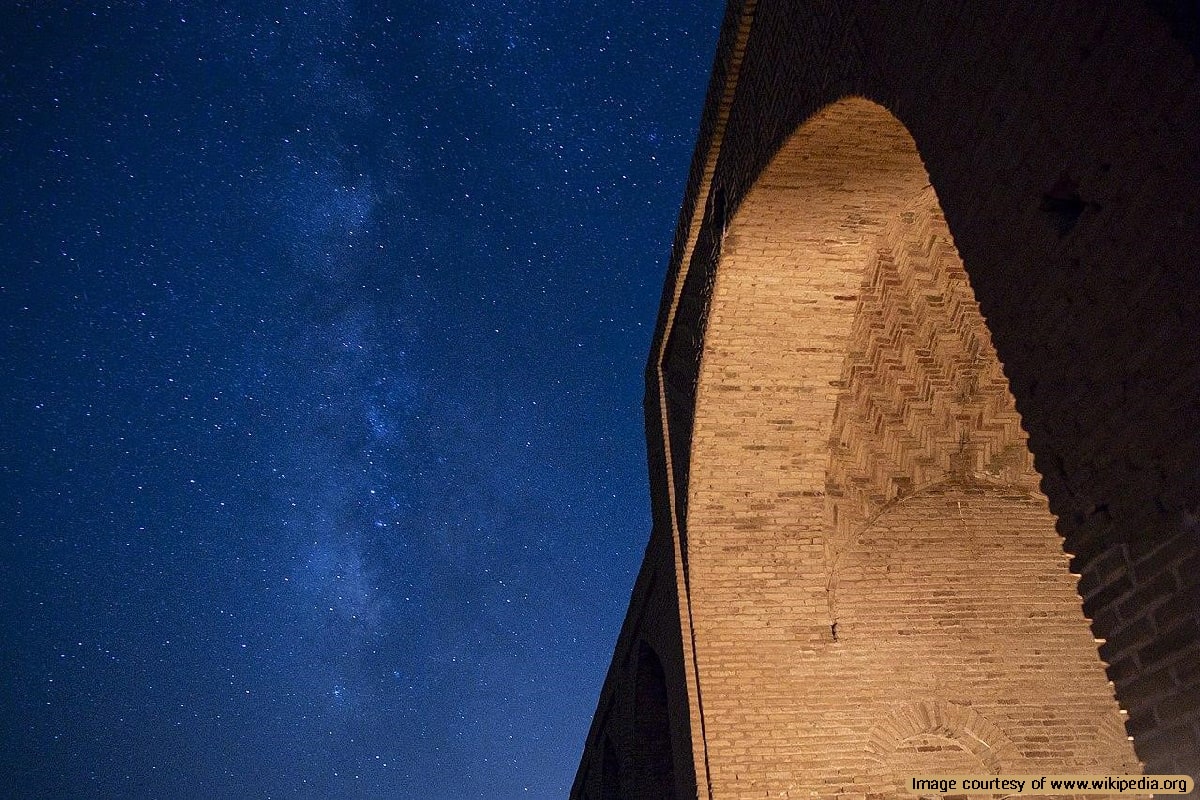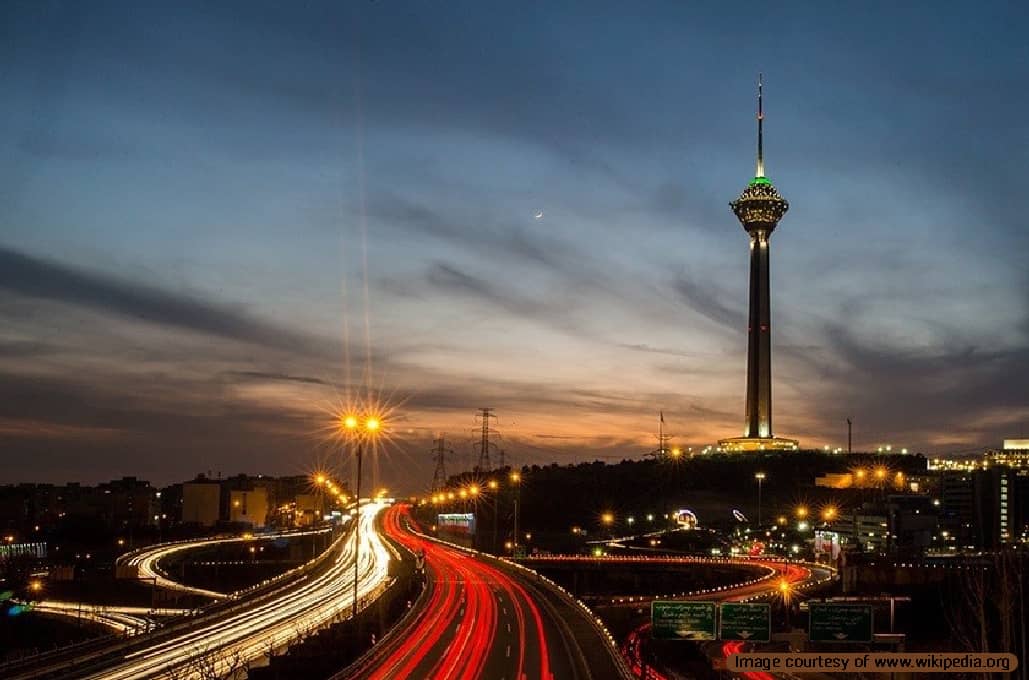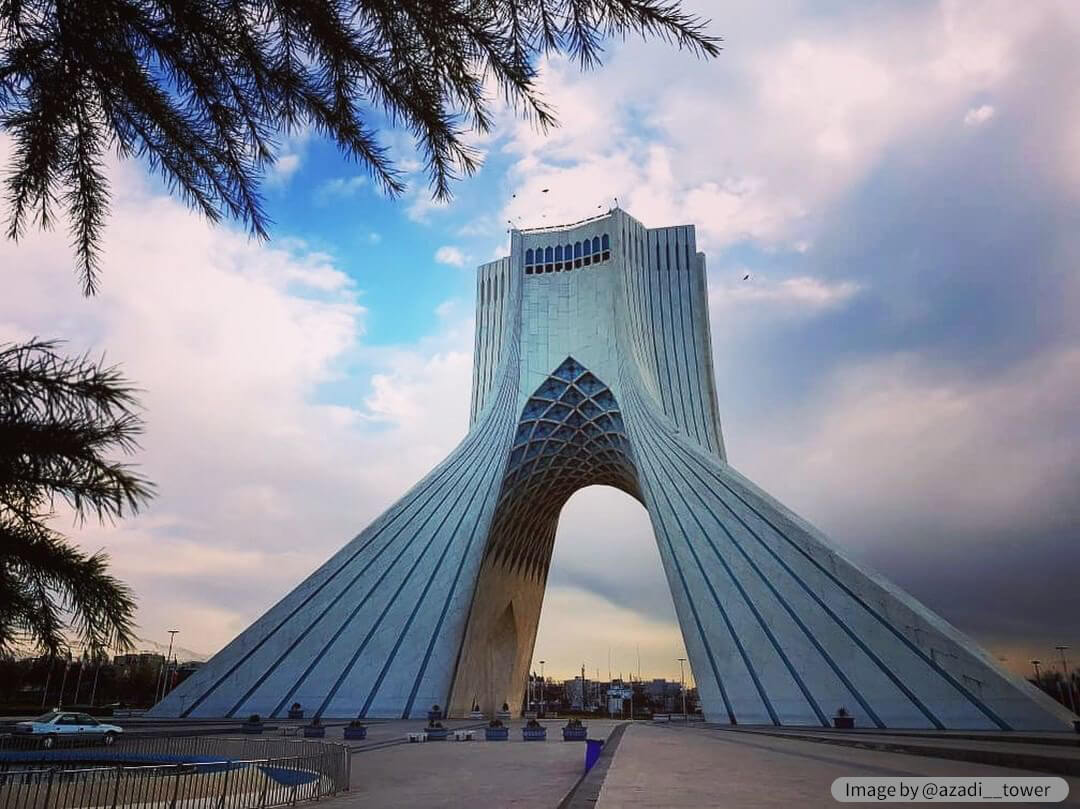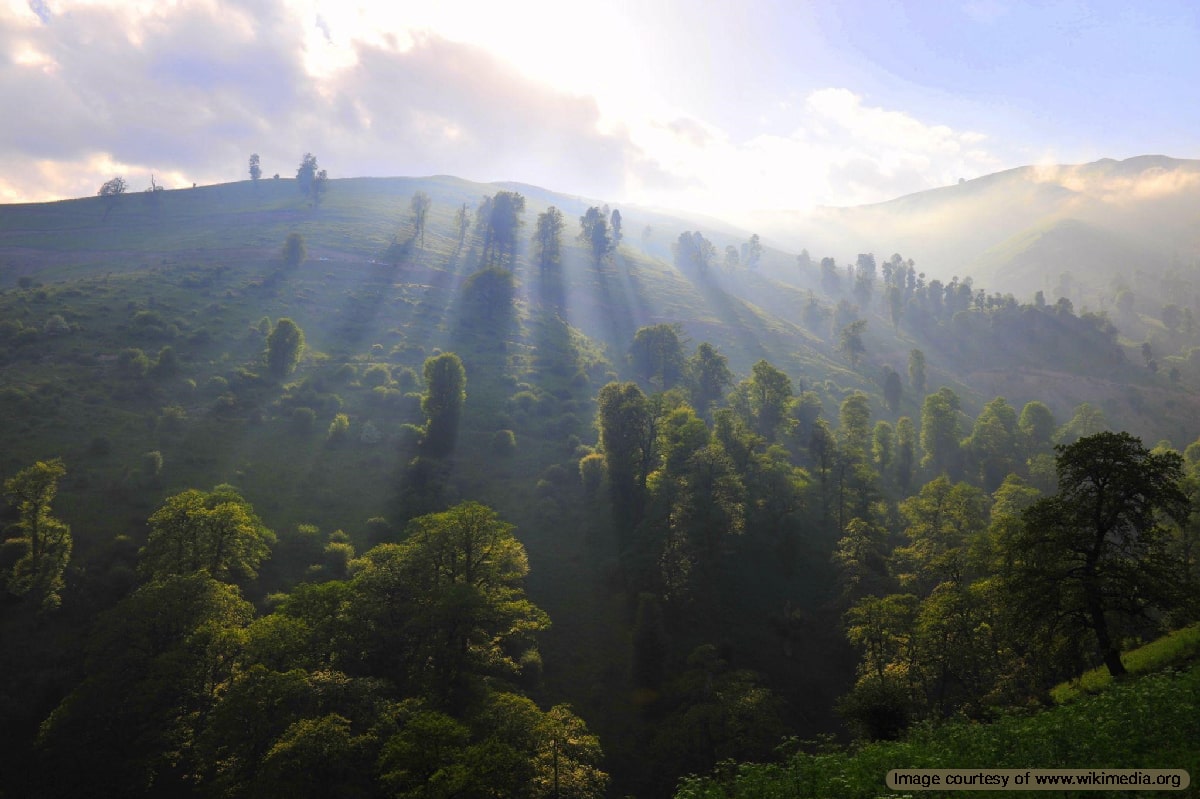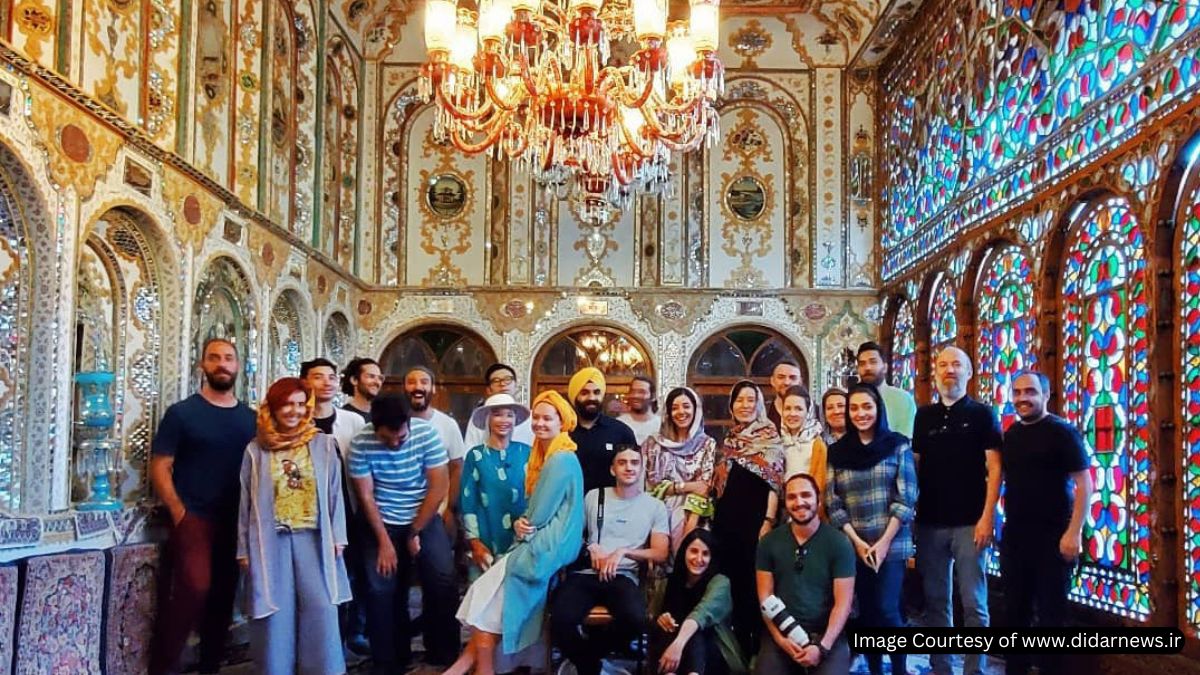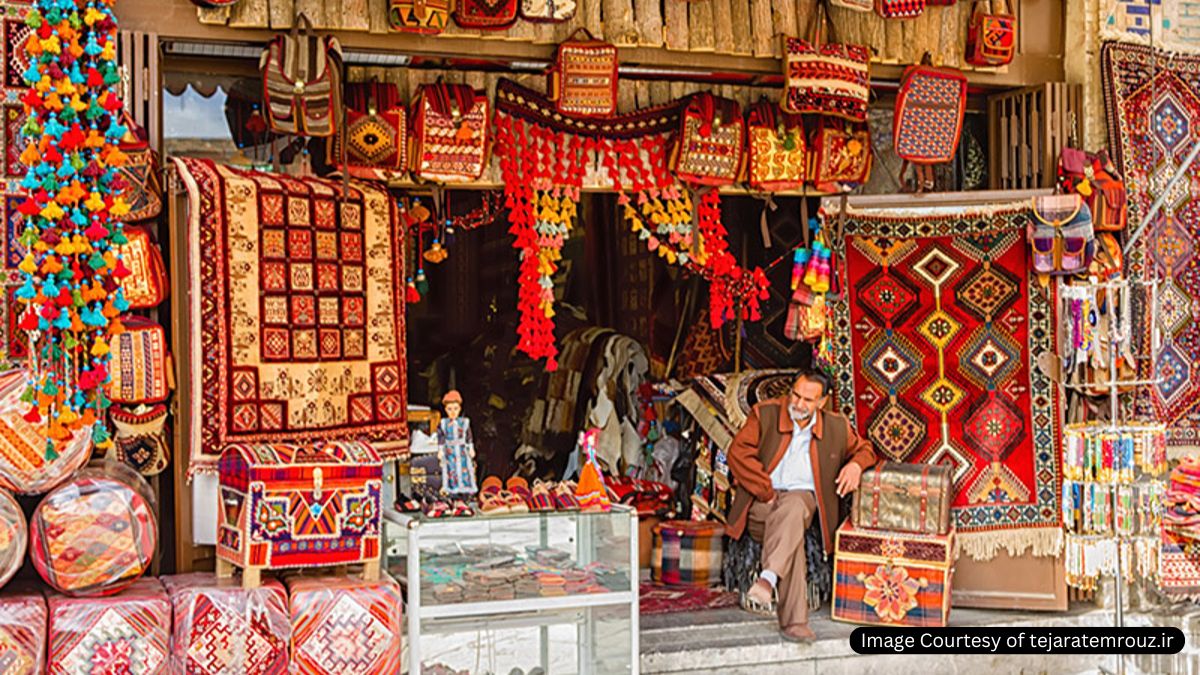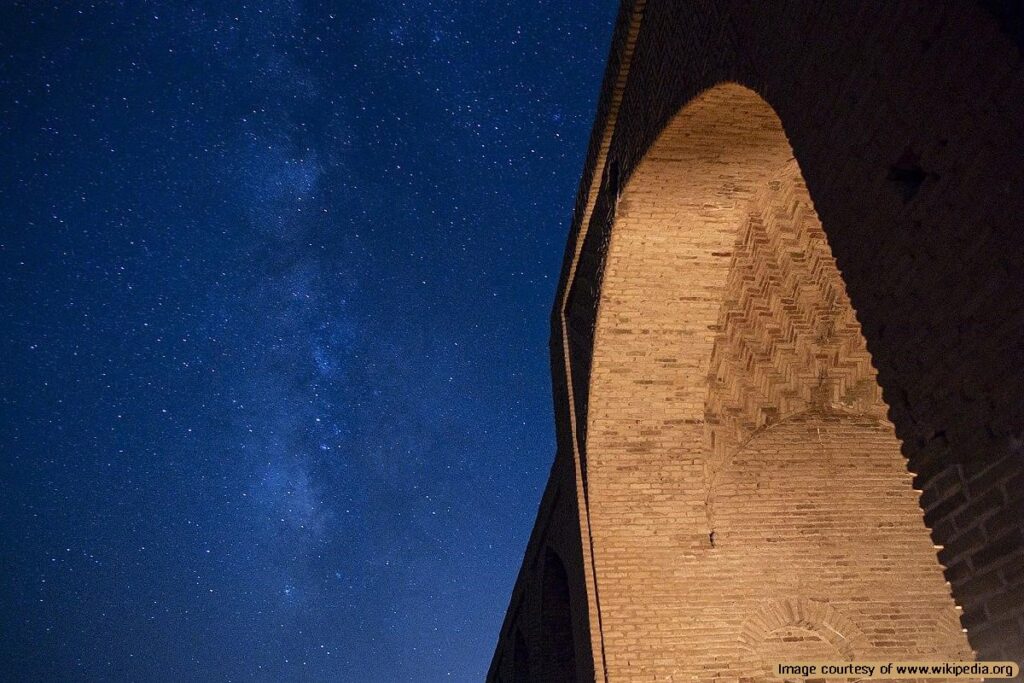
Night sky photography in Iran is a popular activity associated with stargazing. Deserts are the primary location for this activity, and Iran’s central deserts are one of the best spots for astrophotography in the world. The desert’s clear skies and scarce population create the perfect conditions for night sky photoshoots, brought about by the unique distribution of features in Iran’s geography.
In this post, we will cover the requirements and techniques for night sky photography, and introduce some of the top astrophotography locations in Iran with low light pollution and stable atmospheric conditions.
Introduction to Night Sky Photography
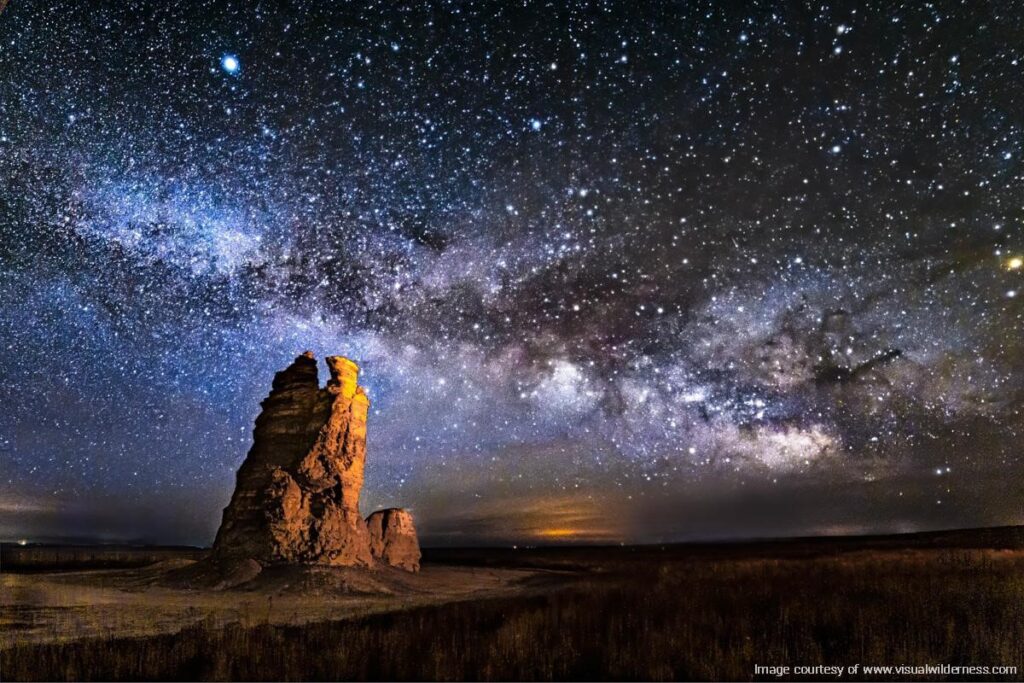
The first high-quality example of night sky photography dates back to 1840 when John William Draper took the first photo of the moon using a new photochemistry technique, daguerreotype. This technique exposed the negative sheet to light for 3-15 minutes and captured a long-exposure shot of the object. Five years later in Paris, Foucault and Fizeau photographed the sun, giving birth to early astronomical imaging.
Since then, astrophotography has come a long way in terms of technology, and now we can capture astronomical bodies at the far ends of the galaxy and beyond. The results of these endeavors have led to advances in astronomy and produced eye-catching pictures of the wonders of space.
Top Night Sky Photography Locations in Iran
The best location for night sky photoshoots should be 100 km from the nearest population cluster, such as cities or villages. This ensures optimal lighting conditions and the elimination of light pollution. The best spots in Iran include old abandoned caravanserai, castles, and other historical ruins. Given the dangerous nature of the desert and the remoteness of the following destinations from cities, we urge the readers to visit them on a group tour, and with an expert guide.
Seh Qaleh Desert, South Khorasan Province
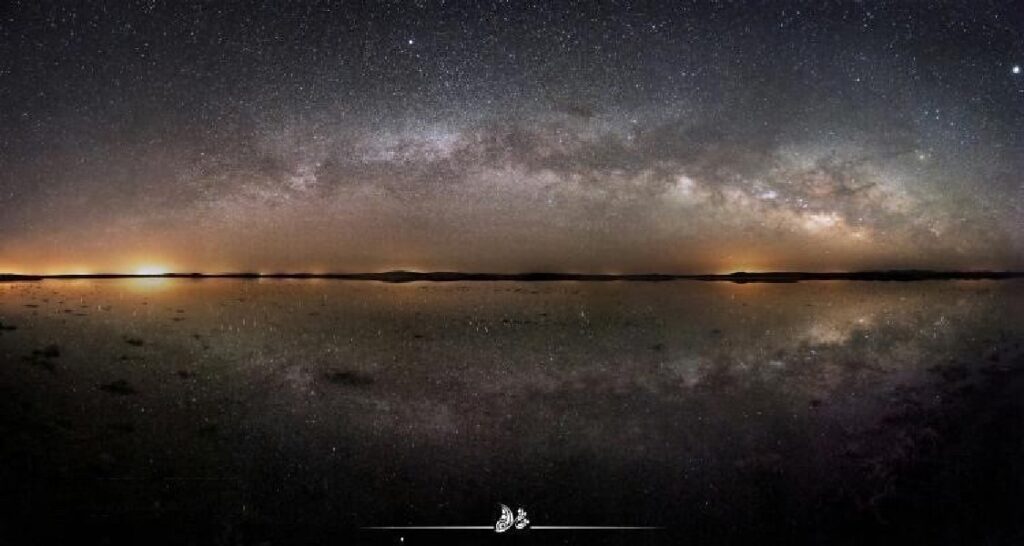
Seh Qaleh Desert is considered a paradise for astronomers and night sky photographers. This desert is home to several tourist attractions such as Fazel Khani Cistern, Ziae historical house, three historical castles, and other attractions. These historical attractions are prime subjects for inclusion in wide-field photography. In addition, the Namakzar ecotourism destination with several forms of desert is one of the best spots for solar system astrophotography.
Radkan Tower, Chenaran, Razavi Khorasan
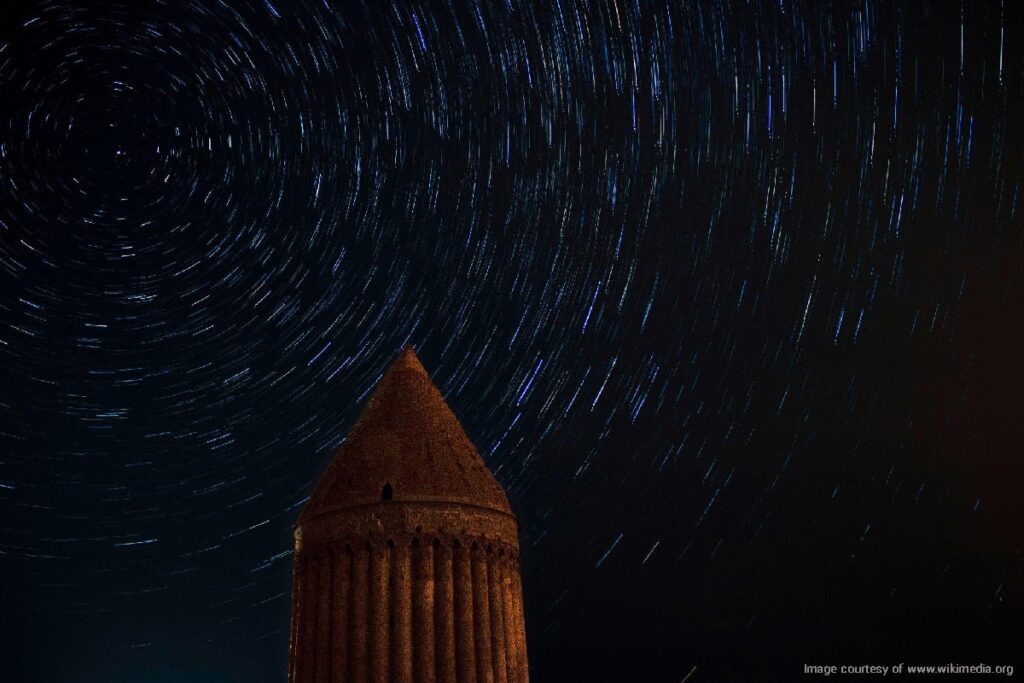
This historical brick tower is an Ilkhante tourist attraction and astronomical observatory built by Nasir al-Din al-Tusi. It helped determine the passage of the four seasons, leap years, and the arrival of Nowruz. The light pollution from the Radkan village is minimal here, and you can take beautiful photographs of the night sky and meteor showers with the tower in the background. This tower is located 74 km north of Mashhad in Radkan village, 36 km from Chenaran city.
Alborz Mountain Range
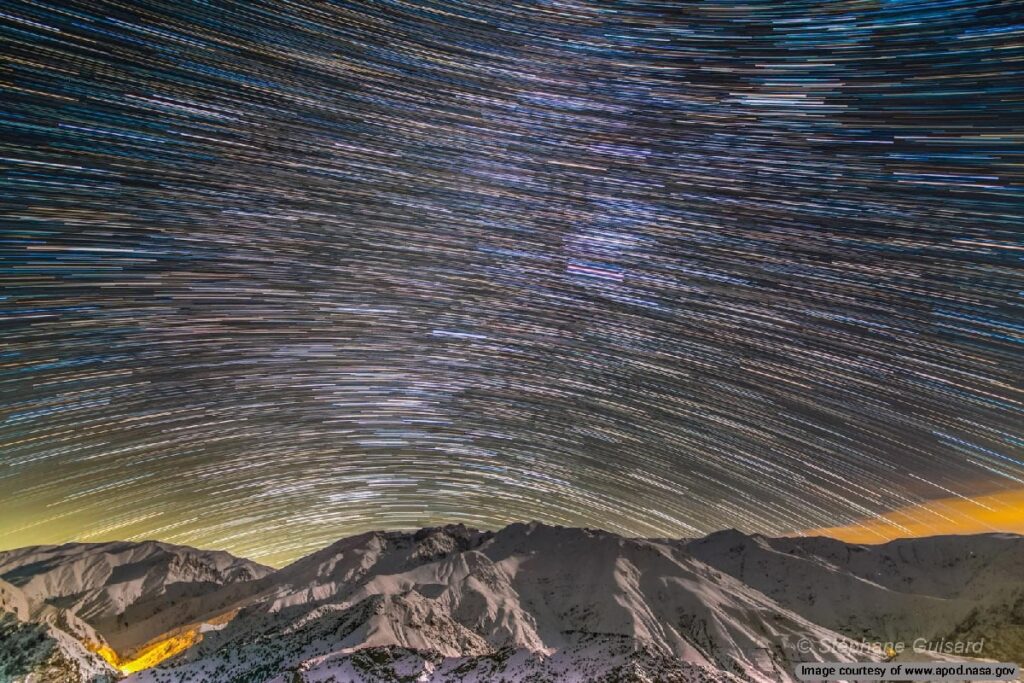
The Alborz mountain range is one of the most popular locations for night sky photography. The thin atmosphere of the mountains and the lack of artificial light sources provide perfect conditions for capturing the stars and planets. To find the best locations for astrophotography, you can visit the foothills of Damavand or other mountains like Savadkuh in Mazandaran.
Qasr-e Bahram Caravanserai, Semnan Province
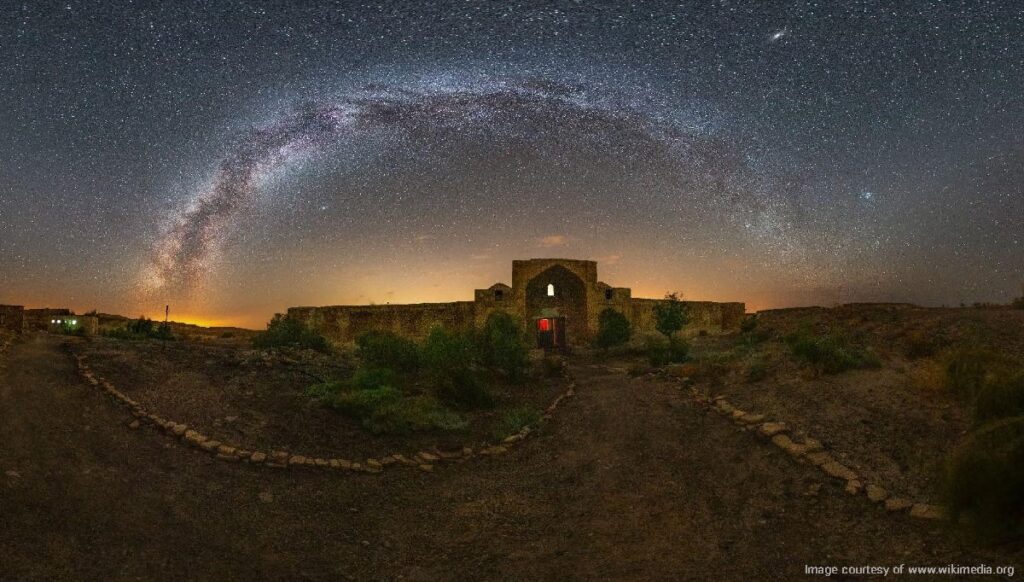
This historical attraction in the heart of Dasht-e Kavir in central Iran dates back to the Safavid era. The light pollution in this location is minimal, and the caravanserai has facilities to accommodate photographers to spend the night. It is located 150 km south of Tehran, near Garmsaar.
Chak Chak Observatory in Yazd Province
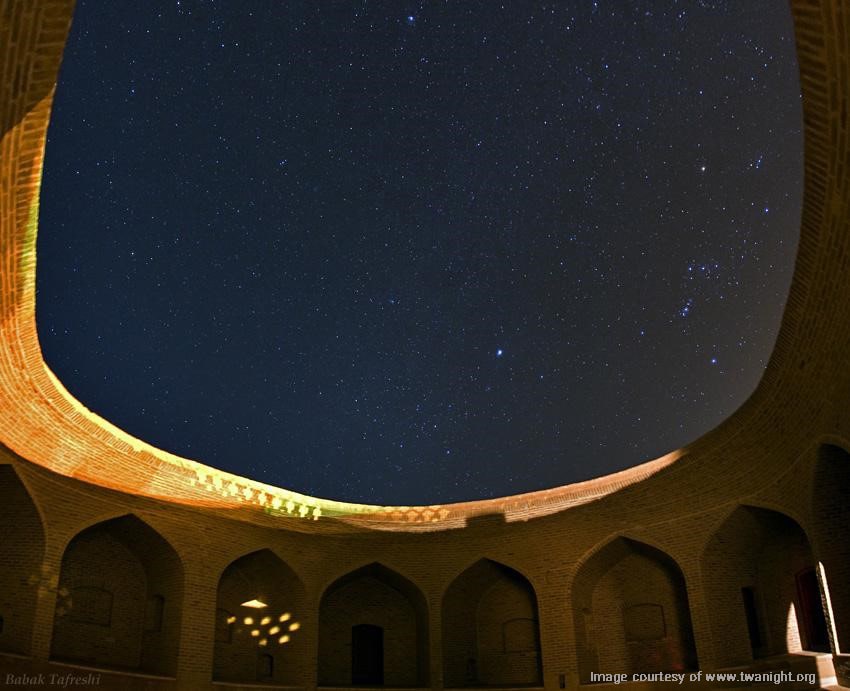
Chak Chak village is a holy Zoroastrian pilgrimage destination surrounded by mountains in the desert of central Iran. This remote observation point provides ample opportunity for deep-space photography and capturing distant nebulas and stars. However, the mountainous surroundings do not allow wide-field photography because they block the horizon. This village is located in Ardakan county north of Yazd province.
Kalut-e Shahdad (Yardangs), Kerman Province
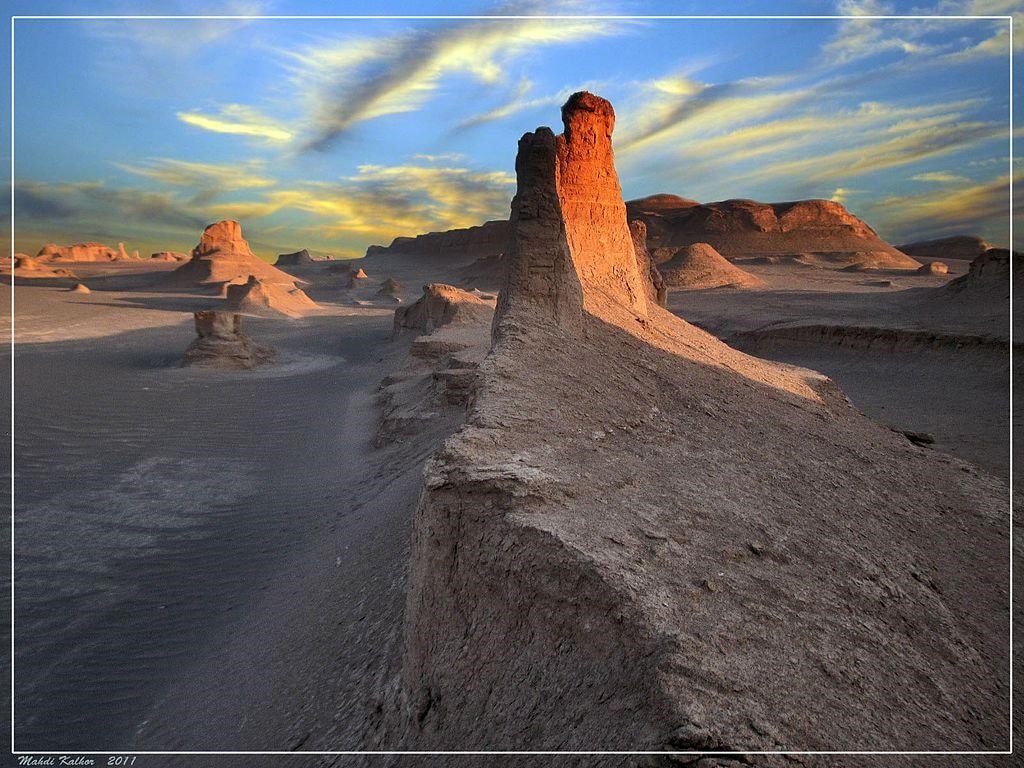
The Shahdad historical site in the Lut desert has the lowest levels of light pollution in Iran. This area is also home to the hottest recorded temperature on Earth at 70.7 Celsius (160 degrees Fahrenheit). This observatory is located in a city of the same name east of Kerman province.
Tabas Desert, South Khorasan Province
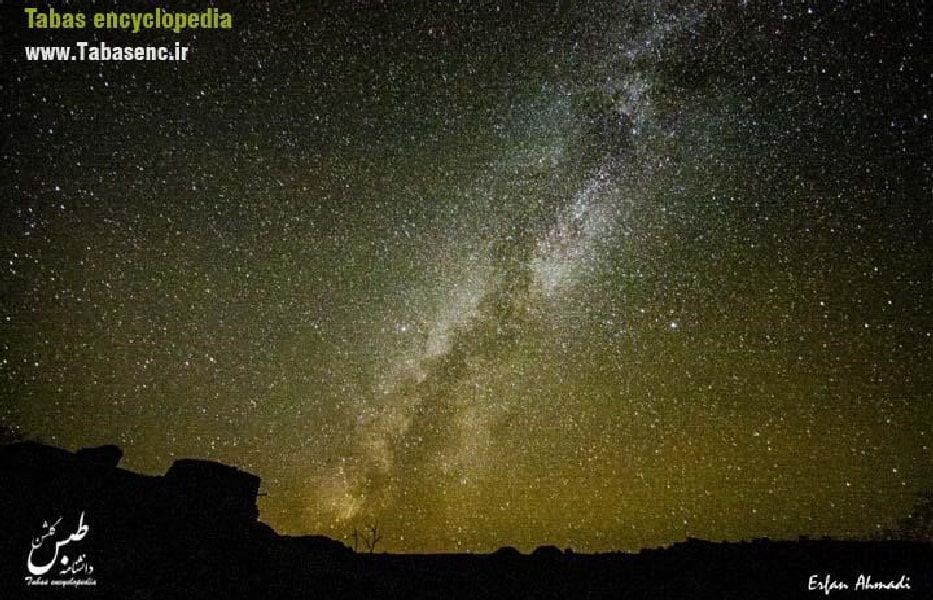
The Naybandan Wildlife Sanctuary in the Tabas desert is one of the areas with the least light pollution in Iran. It is located 180 km south of Tabas city in the deep desert. This national park is home to endangered species such as the Asiatic Cheetah and hyenas. If you are visiting this location, make sure to keep a safe distance from the wildlife to ensure your safety, and theirs.
Maranjab Desert, Isfahan Province
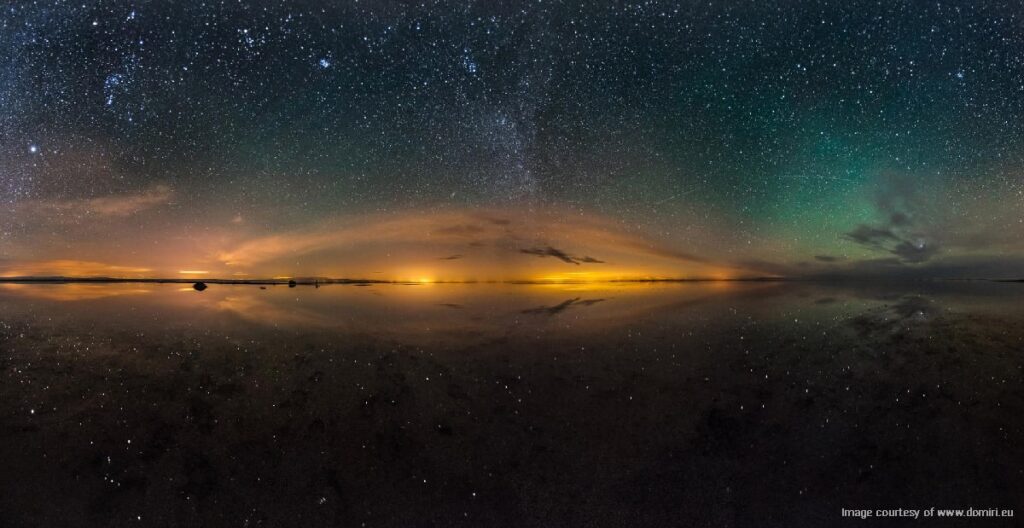
The Maranjab desert in Aran Va Bidgol is a popular destination for astrophotography tours. The Maranjab Caravanserai on the Kashan-Isfahan road is the perfect destination for travelers who want to experience Safavid architecture and escape polluted urban skies to capture the wonders of space. Every year, thousands of travelers take to this desert to witness meteor showers and camp in the desert.
Halvan Desert, South Khorasan Province
This desert is located 90 km northwest of Tabas on the Tehran-Tabas road and is part of the central desert of Iran. Travelers can camp in the Halvan village near this desert to prepare for night shoots. One of the must-see attractions in Halvan is the ancient cave dating back 160 million years, located 15 km from the village.
Takht-e Soleyman Archeological Site, West Azerbaijan Province
Adur Gushnasp is a Sassanid historical attraction and UNESCO World Heritage site in West Azerbaijan Province. This remote location is far from populated areas, 45 km from the nearest city, Takab. The clear skies and distance from light pollution sources create a perfect environment for deep-space astrophotography of astronomical bodies, especially the Milky Way galaxy.
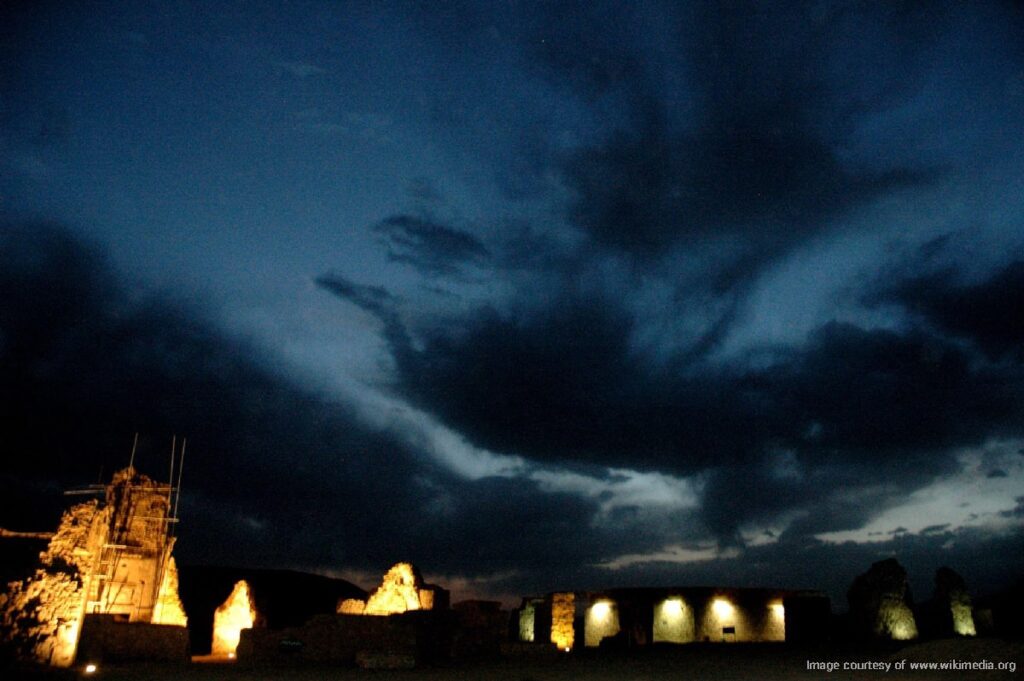
Sufi Abad Village Village, Semnan Province
This remote village is located in Sorkheh County in the south of Semnan Province, on the edges of Dasht-e Kavir. It is home to the tomb of Sheikh Ala ad-Douleh Semnani. The village is scarcely populated and has little light pollution, and you can camp on the outskirts for optimal photography conditions. The last spot to purchase supplies like water and food is the gas station 5 km after Sorkheh, so stock up before camping in this desert.
Khor Village, South Khorasan Province
Khor (Khusf) village is a small village in Khusf Country, west of Birjand with traditional Iranian architecture. This desert area has a small population, which makes it an ideal location for astrophotography projects. It is located on the Tabas-Birjand road after Arab Abad village. The adobe buildings and the desert horizon create a nice atmosphere for wide-field photography. In addition, the clear sky, lack of artificial light, and lack of tall structures help achieve noise-free pictures of deep-space objects.
Mesr Desert, Isfahan Province
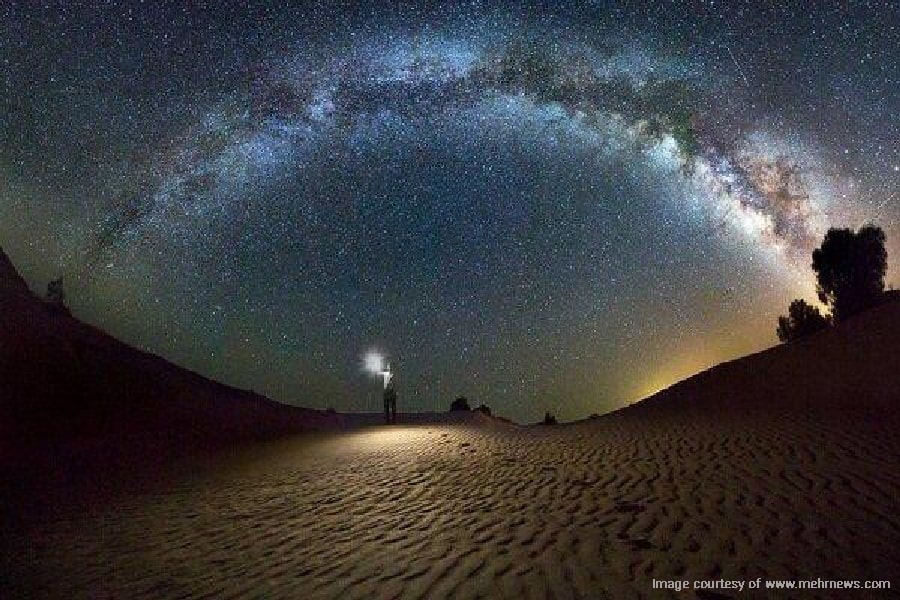
The Mesr village in the Jandaq rural district of Isfahan is a famous tourist attraction among the Iranian deserts. Its vastness, dunes, and proximity to Mesr Caravanserai have made it a popular observatory for both naked-eye stargazing and night sky photography. It is a prime location for capturing various planets in the solar system and star constellations. The desert is located 45 km from Jandaq and 30 km from Khur in Isfahan.
Matin Abad Desert, Isfahan Province
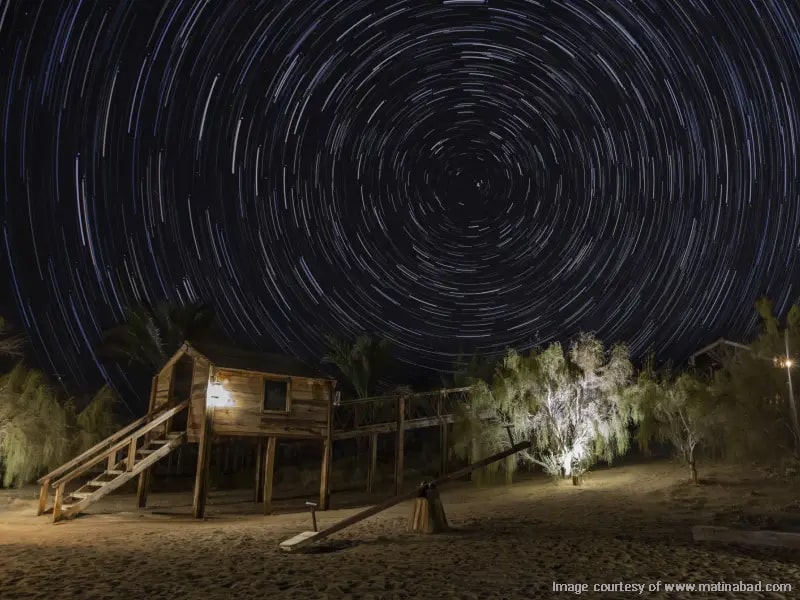
Matin Abad desert is one of the most popular stargazing and astrophotography locations in Iran. It is located near a village of the same name 60 km from Kashan. This destination features clear skies at night and ecotourism accommodations for travelers far from crowded cities. The only access to this desert is a dirt road from Fami village.
Zaman Abad Desert, Semnan Province
Zaman Abad desert is part of the central Iran desert near the Khar Turan National Park and Biosphere Reserve southeast of Shahrud. This desert is located in the vicinity of Zaman Abad village and is considered Iran’s Africa because of its unique biodiversity and natural attraction. The clear night sky and the desert background make this an ideal location for wide-field night sky photography.
Night Sky Photography Types
Three general types of astrophotography have many subcategories. They require specialized equipment and photography techniques. Wide-field, solar system, and deep-sky astrophotography are general categories that vary in subject, difficulty of technique, and required equipment. We will explain the three types and introduce the best locations and specialized equipment.
Wide-Field Night Sky Photography
This is the most popular and accessible type of night sky photography. It requires the least preparation and specialized equipment and is the best option for amateurs. Wide-field photography involves photographing the night sky above a landscape.
This type of sky photography can be carried out with DSLR, digital, or even smartphone cameras. You will need a tripod to hold the camera during the longer exposure process. The ISO sensitivity settings need to be 800, 1600, or higher. It is best to use manual focus to capture the best view of the foreground, like trees, dunes, or a mountain. The general exposure for this type of night sky photography is ¼ to 4 seconds.
Solar System (Planetary) Astrophotography
The subject of this type of night sky photography is the solar system, which includes astronomical bodies such as the moon, planets in our solar system, and asteroid belts. This style of astrophotography requires telescopes, mounts, and specialized filters. Stacking or lucky imaging is one of the popular planetary photography techniques, which involves combining several short-exposure photographs to create a high-resolution image of the subject.
Deep Space Astrophotography
The final frontier in night sky photography is capturing images of astronomical bodies beyond our solar space. They include the Milky Way galaxy and other distant galaxies, nebulas, distant star systems, and other objects light years away. This type of night sky photography requires highly specialized equipment such as GoTo Mount, which uses software tracking to direct the telescope at specific astronomical targets. It also requires narrowed filters to isolate the light from these distant targets and acquire the clearest image possible.
In addition to specialized equipment, deep-space photography requires a location with the lowest light pollution possible. This is why our country’s vast unpopulated deserts are a popular destination for night sky photography in Iran.
Equipment for Night Sky Photography
The equipment required for astrophotography varies based on the type of subject you are trying to capture. As mentioned before, the three general types of astronomical subjects require specific tools which we will describe in the following:
Wide-Field Astrophotography Equipment
Wide-field astrophotography allows you to capture the horizon of the night sky, including star fields, constellations, and the Milky Way. The subject in this type of photography is the field of view, rather than a specific object in the night sky. Here’s what you’ll need:
Camera:
A DSLR or mirrorless camera with manual exposure settings. Look for models that allow exposures up to 30 seconds. Consider a camera with good low-light performance (high ISO capability) for capturing faint stars.
Lens:
A wide-angle lens is essential. Opt for one with a fast aperture (e.g., f/2.8 or wider) to collect more light. The Rokinon 14mm f/2.8 is a popular choice for wide-field astrophotography.
Tripod:
A sturdy tripod to keep your camera stable during long exposures. Consider investing in a quality tripod for long-term use.
Solar System Astrophotography Equipment
Solar system astrophotography lets you capture the planets, the Moon, and even the Sun. Safety precautions are crucial when imaging the Sun:
Camera:
For planetary imaging, a DSLR or mirrorless camera with video recording capability suffices.
Dedicated planetary cameras (like ZWO ASI models) offer higher frame rates and better sensitivity.
Telescope:
A good telescope optimized for planetary imaging. Refractors or compound telescopes (Maksutov-Cassegrains or Schmidt-Cassegrains) work well.
Choose a telescope with a long focal length for detailed views.
Mount:
An equatorial mount with smooth tracking for precise planetary alignment. For solar imaging, a mount capable of auto-guiding is beneficial.
Solar Filter:
Essential for safely observing and imaging the Sun. NEVER look at the Sun directly without proper filtration. Baader Solar Film or specialized solar telescopes with built-in filters are safe options.
Deep-Space Astrophotography Equipment
Deep-space astrophotography involves capturing distant galaxies, nebulae, and star clusters. Here’s what you’ll need to explore the cosmos:
Camera:
A dedicated astronomy camera (CCD or CMOS) is designed for long-exposure imaging. These cameras have high sensitivity and low noise, crucial for capturing faint deep-sky objects.
Telescope:
Choose a telescope with good optics and a suitable focal length. Refractors and reflectors both work well. Apochromatic refractors or astrograph reflectors are excellent choices for sharp images and help better focus on the subject.
GoTo Mount:
An equatorial mount with precise tracking capabilities is essential. It compensates for Earth’s rotation during long exposures. This is crucial when capturing long-exposure images of celestial objects and prevents streaks from appearing during such photos. Auto-guiding capability ensures pinpoint accuracy.
Capture the Clear Night Sky in Iranian Deserts
Astrophotography has gained popularity in recent years, especially in Iran. Thanks to the efforts of Babak Tafreshi, founder of The World At Night project, interest in astronomy and admiration for the night sky has spread in Iran.
The unique geographical features of Iranian deserts have created a popular destination for astrophotographers from around the world. If you are traveling to Iran for such purposes, make sure to find an expert guide to help you discover perfect locations, maneuver the deserts, and enjoy taking photographs of countless stars and celestial bodies.
Frequently Asked Questions About Night Sky Photography in Iran
If you have any other questions about astrophotography or night sky photography in Iran, please let us know in the comments. We will respond as soon as possible.
How do I choose the right equipment for Astrophotography?
Selecting the right gear depends on your goals. For wide-field shots (capturing large portions of the sky), use a wide-angle lens and a sturdy tripod. For deep-space imaging (galaxies, nebulae), invest in a telescope, equatorial mount, and dedicated astronomy camera.
What does “Stacking” mean in Astrophotography?
Stacking involves combining multiple shorter exposures to create a single, noise-reduced image. Software aligns and averages these frames, revealing more details.
How Can I achieve a sharp focus on the stars?
Manual focus is crucial. If using autofocus, focus on the Moon or a distant light source first. Consider using live view and magnification for precise focus.
How can I find dark sky locations in Iran with low light pollution?
Iran offers pristine night skies in certain regions. Deserts like Dasht-e Kavir and heights in Alborz (e.g., Haraz, Firuzkuh) provide minimal light pollution.
How do I capture the Milky Way?
The Milky Way is visible during Iran’s summer. Use a wide-angle lens (f/2.8 or wider) and a tripod. Longer exposures reveal its intricate details. Plan your shoot during the new moon phase for darker skies.
What’s the best way to photograph meteor showers in Iran?
Meteor showers like the Perseids (July to August) are spectacular. Use a wide-angle lens, set a high ISO, and take continuous shots during the peak. Patience is key; meteors can be unpredictable.
Can I capture planets with my camera?
Yes! Use a telescope with planetary imaging capabilities. Planets like Jupiter, Saturn, and Mars are excellent targets. Learn about planetary conjunctions online to find the perfect location and time for photographing plants.






